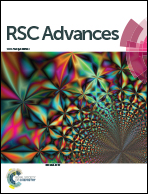One-pot hydrothermal synthesis of platinum nanoparticle-decorated three-dimensional nitrogen-doped graphene aerogel as a highly efficient electrocatalyst for methanol oxidation†
Abstract
Controllable integration of platinum nanoparticles (PtNPs) and a carbonaceous material is a promising strategy to obtain cost-effective and highly efficient nano-catalysts. Three-dimensional (3D) graphene-based aerogel is considered as an ideal catalyst support because it not only possesses the superior properties of graphene, but also can provide a high loading volume with hierarchical 3D porous architectures. In this paper, PtNP-decorated 3D nitrogen-doped graphene aerogel was prepared through a one-pot hydrothermal route for the first time. Compared to PtNP-decorated 3D graphene aerogel or PtNP-decorated 2D graphene, this nanocomposite shows excellent electrocatalytic activity because of the nitrogen doping and 3D porous structure.


 Please wait while we load your content...
Please wait while we load your content...